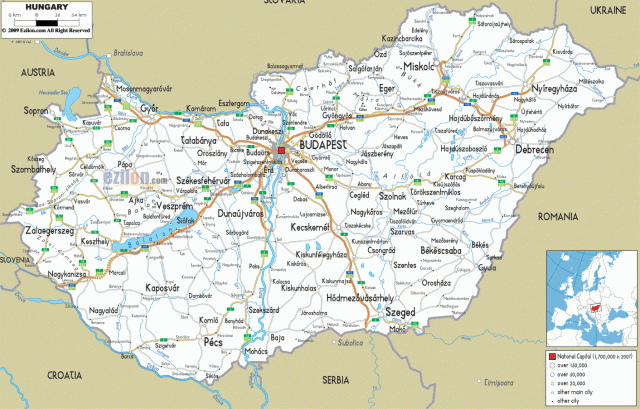Hungary
Area 35,919 square mi (93,030 square km)
Population 9.862 million 2014
Capital Budapest
Highest Point 3,346 ft (1,014 m)
Lowest Point 257 ft (78 m)
GDP $137.1 billion 2014
Primary Natural Resources bauxite, coal, natural gas.
HUNGARY IS UNIQUE among the nations of Europe in many ways: a relatively flat country among hillier neighbors, a homogenous population with a language and culture unrelated to the peoples around them, and a long history as a unified nation in the midst of a region known historically for its diversity and political fragmentation. The nomadic Magyar tribes who emigrated from the area around the Urals around the year 900 C.E. founded a state that has dominated this region of the middle Danube for over a thousand years.
Since the collapse of the Soviet Union's dominance in Eastern Europe in the 1990s, Hungary has emerged as the strongest economy once again in the region and led the pack in its reintegration with the Western world, formally joining the EUROPEAN UNION in May 2004.

Hungary is located at a strategic crossroads between Western Europe and the Balkan Peninsula, and between RUSSIA and the MEDITERRANEAN SEA. Here, the DANUBE RIVER flows through a broad plain with some of the most productive agricultural land in Europe. To the east of the river especially, the Great Hungarian Plain, or Alfold, spreads out for miles of almost completely horizontal fields and grasslands, or puszta. The plain is surrounded by the arc of the Carpathian Mountains, which form the borders with Hungary's neighbors to the north (SLOVAKIA, UKRAINE) and to the east (ROMANIA). To the south, the plain merges into the more hilly neighbors of the Balkan Peninsula (SERBIA AND MONTENEGRO, CROATIA, SLOVENIA), while the west rises slightly in elevation at the foothills of the ALPS on the frontier with AUSTRIA.
Through much of its history, many of these borders were in fact within the kingdom of Hungary, which once encompassed the entirety of Slovakia and Croatia, much of northern Serbia (the Vojvodina), and over a third of Romania (the historic province of Transylvania). After World War I and the Treaty of Trianon (1920), however, non-Hungarian peoples were granted self-rule, and Hungary lost three-fourths of its territory, a fact that continues to influence politics and relations with Hungary's neighbors today.
Landlocked Hungary is dominated by the river Danube (called here the Duna), with its chief tributary, the Tisza, flowing through the eastern part of the country. Other major rivers include the Drava on the southern border, the Raba in the northwest, and the Koros, which flows in from the east. In the central western part of the country, Lake Balaton forms the largest lake in Europe, covering 233 square mi (598 square km). Balaton is well-known for its resorts and for its pike, a national dish of Hungary, served with dill and paprika.
Much of Hungary sits atop large reserves of geothermal, mineral, and curative waters, and Hungarian cities are famous for their spas, some of which have been in existence for centuries. Some of the geothermal spas are located in the mountains of the northern part of the country, where Hungary's earliest industries were centered, mining coal, iron, silver, zinc, and gold until these were mostly depleted. The mines were closed in the 1990s to the great detriment of the local economy. This part of Hungary is also known for its Eger and Tokaj wines.
Budapest, until 1873 the twin cities of Buda and Pest, is the center of the country in every way, geographically, historically, and economically. A fifth of the population lives there, and most of Hungary's industry is centered in the Budapest region. Hungary's other cities are much smaller but play important roles as regional centers: Debrecen, Miskolc, Szeged, Pecs, and Gyor. The eastern plains are sparsely settled, populated instead by herds of horses and cattle and covered with farms raising Hungary's chief products: wheat, corn, sunflower seed, potatoes, and sugar beets. Today, Hungary's economy is the most dynamic in the region, with more foreign investment per capita than any other country in eastern or central Europe.
Tensions remain with some of its neighbors, however, over treatment of their minorities within Hungary's borders, and privileges given to Magyars living outside current borders (especially in Slovakia and Romania). The divisive spirit of nationalism also has called for renewed discrimination against one of the largest populations of Romany in Europe, with numbers running from an official count of 142,683 in 1990, to unofficial estimates of up to 600,000.